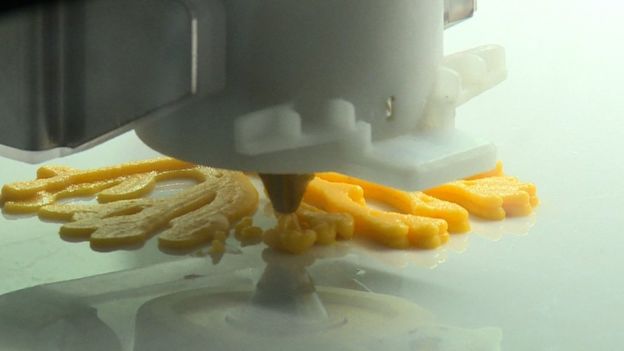The machine he is using is called Foodini, and is made by Natural Machines, a new company based only a few miles away from La Enoteca.
Barcelona is certainly a fitting place for a business trying to bring fine dining and technology together. It’s located in Catalonia, a part of Spain renowned for culinary excellence. Celebrated chefs from the region are famous for pushing the boundaries of gastronomy ever further.
Unlike some other food-capable 3D printers, the Foodini device has been designed from the start to be a specialised food-printing machine.
It can print with a very wide range of foods, from mashed potato to chocolate. Ingredients are placed in stainless steel capsules, which are reusable.
With suitable ingredients the machine is capable of printing structures several centimetres high, making possible some quite elaborate 3D designs.
It is also a so-called “internet of things” appliance – which means that it can be connected to the internet, and recipes and designs can be uploaded from anywhere.

Natural Machines co-founder Lynette Kucsma says they have had a lot of interest from top chefs for two main reasons.
One is customisation, enabling the creation of dishes that are just not possible to make by hand.
“The other reason is automation”, she says. “Imagine you need to print breadsticks in the shape of tree branches for a hundred people sitting that evening. Rather than food piping it or doing that by hand, you can automate it with a 3D food printer”.
Ms Kucsma says the professional market is likely to be less interested in printers that can cook as well as print food, since they have many other means of cooking at their disposal. The main appeal of the machines will be their ability to customise and create dishes never before possible.
But despite all the creative possibilities that makers of these devices say they have to offer, isn’t there a danger that they will instead stifle creativity? If a machine combined with computer software is doing all the work, where is there room for the magic, human touch of the gifted chef?
Mr Perez dismisses such concerns: “In its day, traditional food was the avant garde. The people who cooked it would use a blender, or a microwave, an oven, a heat lamp…You see, tradition is innovation – and always has been. In moving forwards, technology will always be present.”

